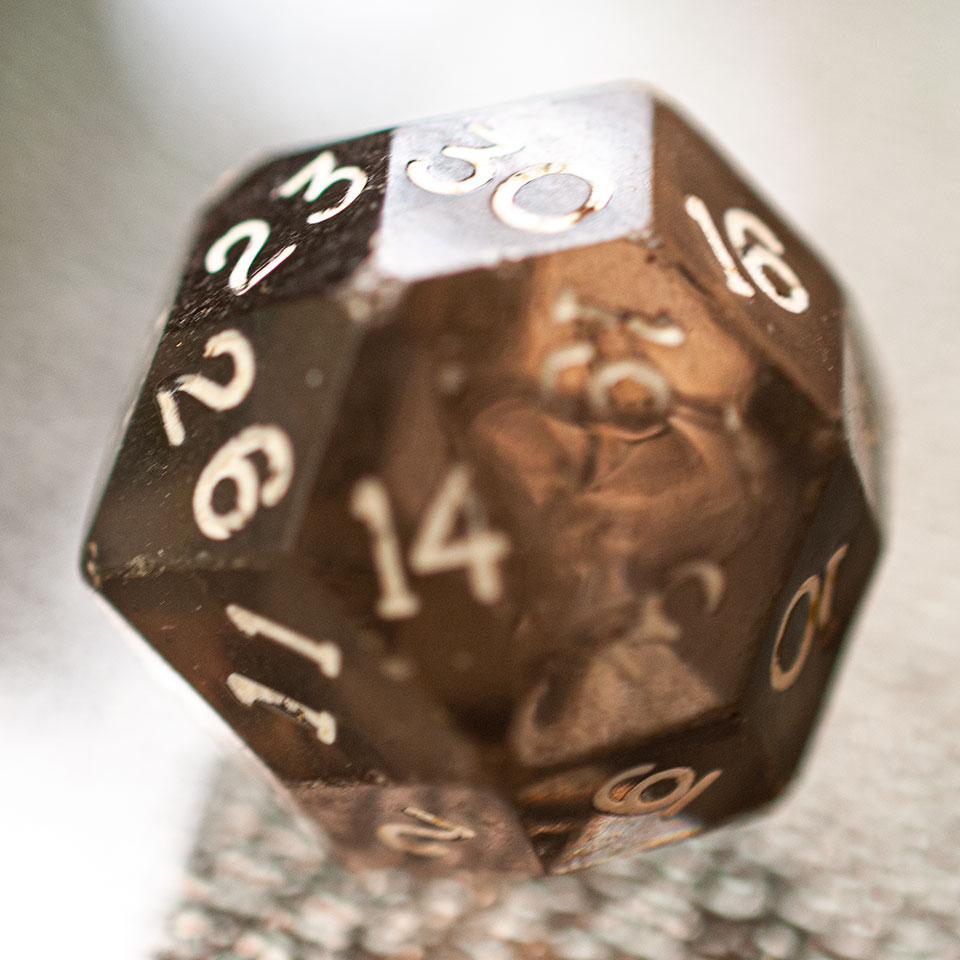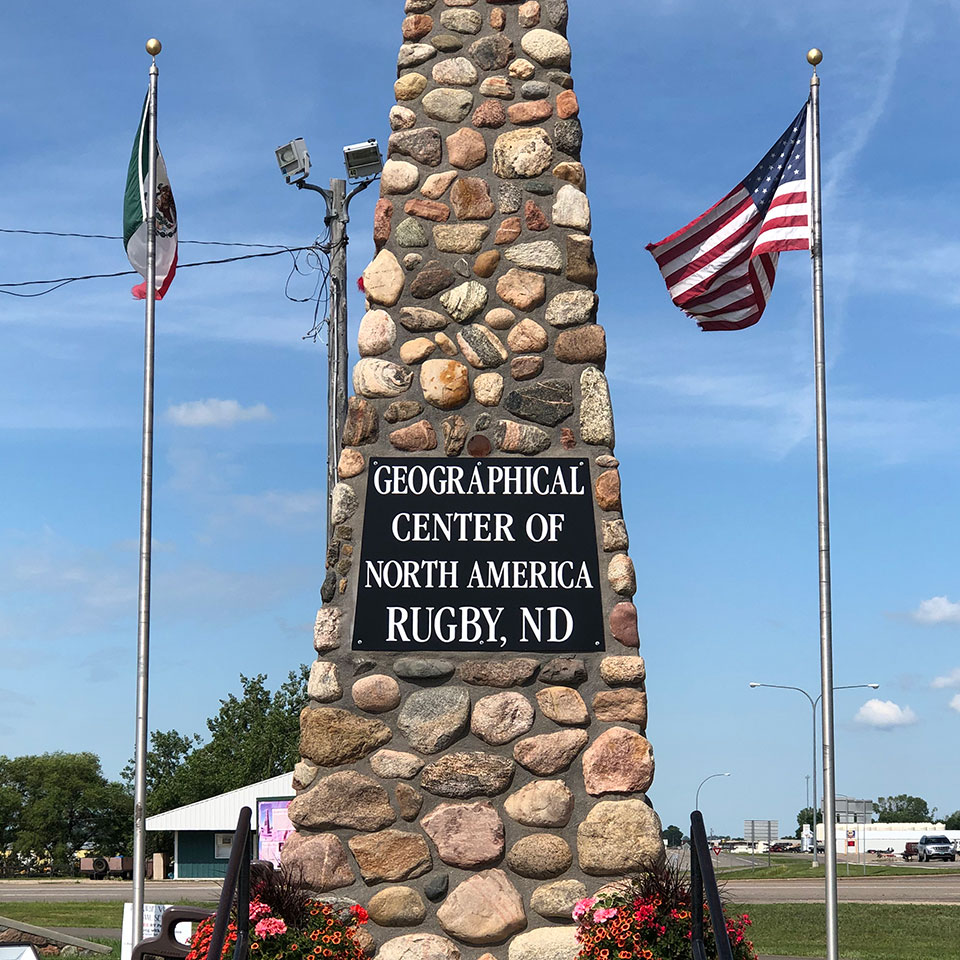
The Die of Tomorrow, Today
a love poem to the greatest die you'll ever own (and never use)
To be fair, i.e., to be as random as is theoretically possible, a die must have perfect symmetry. Each face, edge, and vertex must be identical to every other face, edge and vertex, which makes the chance of landing on any given face roughly equal.
The only polyhedra that fit that description are the five Platonic solids, three-dimensional shapes constructed from identical regular polygons. The equilateral triangle gives us three Platonic solids: the four-sided tetrahedron, the eight-sided octahedron, and the twenty-sided icosahedron. The square gives us the six-sided cube, and the pentagon gives us the twelve-sided dodecahedron.
Of these polyhedra, the six-sided die is the most popular (being the easiest to manufacture), but the other four dice have a long history as well. The four-sided die was used in ancient Sumeria to play a backgammon-like game. Twelve- and twenty-sided dice have been discovered in ruins dating back to Ptolemaic Egypt. Having said that, for the greater part of history the other dice were curiosities that saw little use.
Then, in the mid-1800s, the Germans developed a new game: the tabletop wargame. Soldiers soon found that a six-sided die couldn’t provide quite the level of randomness or detail that their mock battles needed. They embraced the other dice with relish, and even added a new one.
You see, a fair die only has to be perfectly symmetrical if you are obsessed with mathematical purity. If that’s a secondary concern, you can get away with using any shape whose faces are identical. One particularly useful polyhedron here is the trapezohedron, which is constructed interlocking kite-shaped trapezoids and looks kind of like a diamond. It’s particularly useful because it can be used to make a die with any even number of sides.
In the late 1890s some clever manufacturer developed a process for making pentagonal trapezohedrons, ten-sided dice. By rolling one die wargamers could get a number from 1 to 10, and by rolling two dice in conjunction they could generate any number from 1 to 100. That gave them highly granular results they could use to make their simulations increasingly realistic.
But that was about it, really. Six acceptable shapes for dice, only one of which was widely used.
Enter the Dungeon
In 1974 two Wisconsin wargamers named E. Gary Gygax and Dave Arneson gave the world a new kind of game — Dungeons & Dragons, the first fantasy roleplaying game. To say that it was a huge hit is an understatement. The wargaming community embraced it whole-heartedly and eventually the general public took notice. It quickly became one of the best-selling games of all time and made the game’s publisher, TSR, a forced to be reckoned with.
Dungeons & Dragons made use of every die that Arneson and Gygax could find in their game collections. Twenty-sided dice were used for conflict resolution. Ten-sided dice could be used to roll on a bewildering array of loot tables. Four-, six, eight- and twelve-sided dice were used for different types of weapon damage.
TSR realized that not everybody would have these unusual dice lying around the house. So they purchased cheap polyhedral dice in bulk from China and included a full set with every copy of D&D. The game’s runaway success, though, meant that the demand for these dice soon outstripped the supply. TSR was reduced to shipping copies of the games with a bag of numbered chits and a coupon that could be redeemed later for a full set of dice.
That stumble allowed new players to enter the dice-making game. After all, dice are easy money. They can be manufactured in truly staggering quantities, use only a few pennies worth of plastic, and sell for a significant mark-up. All you have to do is be mindful of your quality control and keep an eye on your inventory. Dozens of new companies started manufacturing polyhedral dice for D&D players, including still-active giants of the industry like GameScience and Chessex. And the Armory.
The Armory was founded by hobby store owner Roy Lipman to be a wholesaler distributor of niche items like board games, model trains, slot cars, and historical miniatures. The company jumped on the D&D train early and rode it hard. They started their own private-label line of fantasy miniatures, along with the paints and brushes necessary to decorate them. And of course, they had their own dice, produced right in Baltimore by a local plastics company.
When you have a crowded market, companies scramble to find something that distinguishes their product from their competitors, and the dice market is no exception. GameScience, for instance, famously claimed that its dice were better-crafted and produced truly random results. Other companies produced dice with higher-grade plastics that took longer to wear down and lose their shape. The Armory, on the other hand… The Armory wanted their dice to be cool.
They started off small, by offering dice in a wider range of more appealing colors. Then they expanded into translucent “gem” dice which looked absolutely stunning. Soon they were offering such novelties as gold-plated dice, glow-in-the-dark dice, and scented dice.
At their peak, the Armory was producing over five million dice per year, but they were always looking for the next big thing that could help their products stand out.
The Super Random Number Generator
The next big thing came from John Handwork, a freshman at Virginia Tech.
There was a huge gap in the numbers you could generate with dice, from twenty to one hundred. And if you’re trying to create a simulation of real life, there are many circumstances where twenty potential outcomes were not enough, but one hundred outcomes were way too many. There were solutions to generate numbers in-between. You could roll modifier dice, but the tables felt weird. You could roll multiple dice and total them up, though that would give you an uneven distribution of results that might not be desirable.
Handwork looked at some of the polyhedra that fell into the second category of fairness, wondering if some of them could fill that gap. Many of the shapes were unwieldy or impractical to make, or had a strange number of faces. One shape leapt out at him — the rhombic triacontahedron, a thirty-sided shape composed entirely of golden rhombuses. To fit legible numerals on each face, the die would have to be a monster; double the size of most other dice, about the size of a ping-pong ball. Some plastic manufacturers thought a beast like that would be impossible to make.
Handwork thought differently. But he didn’t have the resources to make the die himself, so he sold the idea to the Armory. They set their plastics guys on it immediately.
As expected, there were problems. The mold for the thirty-sided die cost $15,000, double the price of the molds used for other dice. The large size of the mold required more plastic, which increased the chances of gas pockets inside the finished product, which meant the resulting dice did not roll true and were more fragile.
Eventually the Armory was able to iron out the kinks and bring the thirty-sided die to market in 1982, at price points ranging from $1 to $3, depending on whether it was opaque or translucent, inked or plain. They marketed it as “the super random number generator” and “the die of tomorrow, today.” They even put some of those translucent rejects filled with gas pockets on the market as “soda pop dice.”
And it sold! Boy, did it sell. But why?
Well, first, it was novel. The first new die the role playing game business had seen. That novelty was enough to generate the first wave of sales.
Second, it’s a striking die. As mentioned, it’s about twice the size of its nearest neighbor, the twenty-sided die. It’s big and colorful and eye-catching. It has a pleasing heft in your hand and it rolls really well. I mean, really well. If you like rolling dice, it’s probably the most fun you can have rolling a die.
And finally, the Armory realized that you needed to give people something to do with the die. So they put out a series of cheap booklets featuring an assortment of random tables using the thirty-sided die, usable with D&D or any other role playing game system.
The first book, by Donald Cole, is… not good. It feels less like a supplement and more like a catalog for the Armory’s miniatures line with a few random tables sprinkled into it. And the tables themselves are not good. About a third of the tables are useless window dressing, like figuring out the exact weight of a gnome or height of an elf. It’s a dry, flavorless tome.
Later entries in the series, by game designer Bob Liddil, leaned heavily into Liddil’s sense of humor with slightly silly tables like “Things Slipped Into Your Rucksack by Your Aunt Millie (Who Loves You).” And that too, became a selling point. The thirty-sided die was the quirky die for quirky gamers. And it’s a good thing the Armory made their own market for the die, because it absolutely failed to catch on otherwise.
Not surprisingly, D&D ignored the thirty-sided die. The game had no real need for a new die, and TSR wasn’t going to change the game to give a sudden windfall to a competitor’s patented product. There are a few issues of Dragon magazine in the mid-’80s that mention it off-handedly, but it’s probably a telling sign that the most prominent reference is this letter to the editor from Dragon‘s “April Fool’s” issue in 1989:
Dear Dragon:
Want me to send you a quick and easy system for picking up girls, using the 30-sided die?
Yes, but not for publication.
It didn’t really catch on with other games, either. Even Earthdawn, FASA’s attempt to combine the “let’s roll a ton of dice” mechanic from Shadowrun with a determination to use every die a D&D player might have lying around, ignored it. Its use was mostly restricted to niche games like like comedy RPG Tales from the Floating Vagabond, racing board game Formula D, and convention time-waster Button Men.
So for years the thirty-sided die remained the weird niche die, absent from most gamers’ dice bags and largely unused even by those few quirky gamers who bought them. The Armory did fine even with the declining sales, eventually merging with Chessex in 1998 to form Alliance Game Distributors, the largest game distributor in the United States.
And then, twenty years later, something funny happened.
In the early 2000s there was a playing game revival, fueled by players pulled in by the third edition of Dungeons & Dragons. And there was a counter-movement, formed by grognards both energized and aggravated by the newcomers. They found each other on the Internet and started an “Old School Renaissance” inspired by the simpler games they’d played decades ago. (Or in some cases, stories they’d heard about a game they’d never played.)
And one of their inspirations was the thirty-sided die.
Quirky gamers of all stripes started sharing quirky, fun random tables to use their favorite (but least use) gaming accessories, giving it new life. A few of them even banded together in the “Order of the D30,” which sadly is no longer with us. (Damn you, Google+!) But the tables are still out there, more of them every day, introducing the love of the thirty-sided die to a new generation.
I realize this seems like much ado about nothing. At the end of the day we’re still talking about a 1″ diameter hunk of plastic of extremely limited use that somehow manages to cost more than a Big Mac. But I think it’s one of those weird situations where to know something is to love something.
I still remember the first time I saw a thirty-sided die, a black “soda pop” die gleaming in the fluorescent lights of a hobby shop in the Bazaar of All Nations in Clifton Heights, PA. It was love at first sight. I still have that die today, sitting right next to me as we record. It’s a little worse for wear — the edges aren’t as sharp, at least one vertex has completely sharded off, and some of the Crayola I used to fill the numbers is starting to flake out — but I hold on to it with pride.
I think if you could have one of these in your hands and look at it with the eyes of a child, you’d fall in love with it just like I did that day thirty-five years ago.
Sources
- “A Brief History of Polyhedral Dice.” Save vs. Dragon. http://savevsdragon.blogspot.com/2011/11/brief-history-of-polyhedral-dice.html Accessed 2/20/2020.
- “The Armory.” Tome of Treasures. http://tomeoftreasures.com/tot_nontsr/armory/armory.htm Accessed 2/2020.
- “The Armory dice: an evolution.” The Dicemeister. http://thedicemeister.blogspot.com/2012/03/armory-dice-evolution.html Accessed 2/20/2020.
- “Fair Dice (Part 1).” Numberphile. https://www.youtube.com/watch?v=G7zT9MljJ3Y Accessed 2/18/2020.
- “Fair Dice (Part 2).” Numberphile. https://www.youtube.com/watch?v=8UUPlImm0dM Accessed 2/18/2020.
- Cole, Donald. 30-Sided Gaming Tables. Baltimore: The Armory, 1982.
- Liddil, Bob. 30-Sided Character and Other Tales. Baltimore: The Armory, 1986.
- Liddil, Bob. 30-Sided Adventure and Other Tales. Baltimore: The Armory, 1990.
- LeBlanc, Richard J. Jr. AX1: d30 DM Companion. New Big Dragon Games Unlimited, 2012.
- LeBlanc, Richard J. Jr. AX2: d30 Sandbox Companion. New Big Dragon Games Unlimited, 2013.
- Meyer, Philip. “Magic Items for Everyman.” Dragon #45 (January 1981).
- Collins, Arthur. “Thrills and Chills.” Dragon #68 (December 1982).
- McGuire, Patrick A. “Dice makers roll up big profits.” Baltimore Sun, 24 Feb 1985.
- Parker, Arn Ashleigh. “No Quarter.” Dragon #127 (November 1987).
- Moore, Roger. “Letters.” Dragon #144 (April 1989).
- Reese, Heather. “Staying in the game.” Baltimore Business Journal, 24 Feb 1997.
- Kooser, Amanda. “Ancient d20 die emerges from the ashes off time.” C|Net, 9 Nov 2012. https://www.cnet.com/news/ancient-d20-die-emerges-from-the-ashes-of-time/ Accessed 2/20/2020.
Categories
Tags
Published
First Published:
Last Edited:


